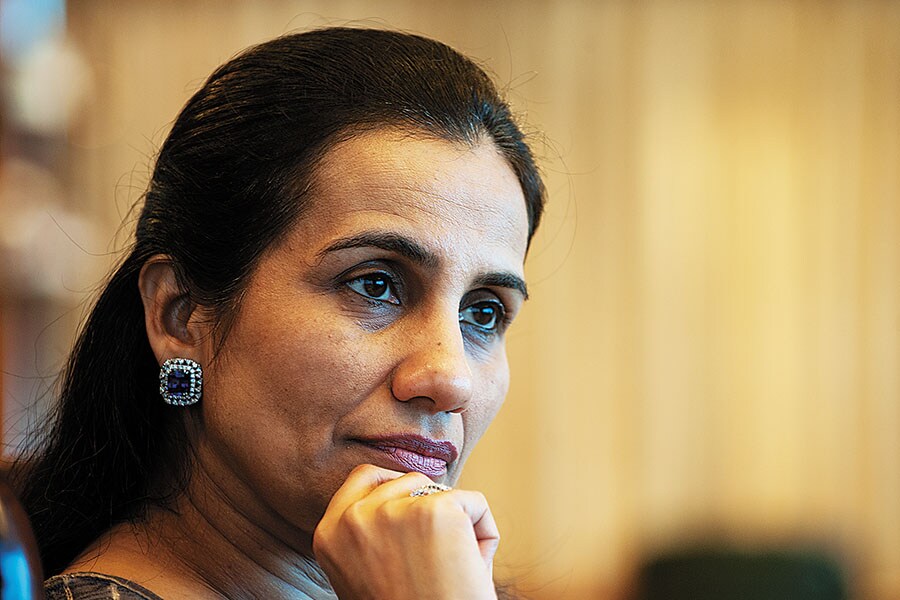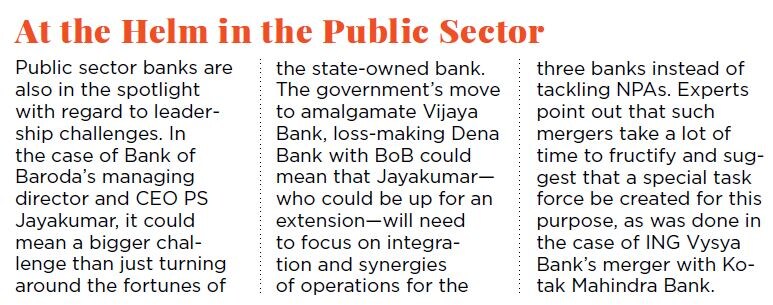Banking leadership crisis
Leadership upheavals at major banks might mean opportunity, but incoming new bosses have their work cut out for them


 The RBI has capped Yes Bank founder Rana Kapoor’s tenure till January
The RBI has capped Yes Bank founder Rana Kapoor’s tenure till January
Image: Kunal Patil / Hindustan Times via Getty Images
Banks in India might never be in for a more challenging, or should one say, exciting phase. In the next two years, some of the biggest new private sector banks in India—ICICI Bank, Axis Bank, Yes Bank, IndusInd Bank and HDFC Bank—will have new leaders.
The exits of the leaders of three banks—Chanda Kochhar, former managing director and CEO of ICICI Bank, Shikha Sharma, CEO of Axis Bank, and Yes Bank’s MD and CEO Rana Kapoor—are against their wishes. Kochhar, 56, was in exile since June 1 until an internal inquiry submitted a report on allegations of quid pro quo against her and her family for loans given by the bank to Videocon Industries in 2012. She sought early retirement, which the bank’s board approved this month. Sandeep Bakhshi, an ICICI group veteran of 32 years, who took over as chief operating officer in July, has taken charge.
Axis’s Sharma and Yes Bank’s Kapoor are set to leave their respective posts in the first month of 2019 as well. Their exits are linked to the Reserve bank of India’s scrutiny on corporate governance risks, after huge divergences were noticed in the reporting of non-performing assets in the past two years.
Two other veteran bankers, Romesh Sobti, managing director and CEO of IndusInd, and Aditya Puri, managing director of HDFC, are set to serve out their terms by March 2020 and October 2020, respectively. Puri is possibly the longest serving head of any banking institution in India—he will have completed 26 years after taking charge in September 1994.
This means that a whole set of leaders will come to the fore in banking, possibly for the first time in over 25 years when the RBI paved the way for the entry of new private banks by issuing licences to four of them—ICICI, HDFC, Axis and IndusInd—between 1990 and 1994.
The effect of the transition will be most critical for and deeply felt by Yes Bank. The RBI, on September 20, granted Kapoor—who along with his brother-in-law late Ashok Kapur founded the bank in 2004—time to continue only till January 31, 2019, as against the bank board’s approved term of three years that would have ended in September 2021.  ICICI’s Chanda Kochhar has taken early retirement following a conflict of interest inquiry
ICICI’s Chanda Kochhar has taken early retirement following a conflict of interest inquiry
Image: Vikas KhotThe stock plunged to an intraday low of ₹172.5 on September 28 at the BSE, against ₹343.6 on September 5, spooked by concerns that the bank might not find an able successor quickly and how that’ll affect its growth. Several equity research firms downgraded the stock last month.
Kapoor’s leadership had come under scrutiny after the RBI said Yes Bank had reported lower non-performing assets in FY17. The RBI, as part of its annual risk-based supervision exercise in 2016-17, asked Yes Bank to report gross non-performing assets (NPAs) of ₹5,891.6 crore against the ₹1,072 crore that it had reported, resulting in a divergence of ₹4,813 crore. There was also a divergence in the provisioning of ₹1,535 crore. The bank finally reported an ‘adjusted’ lower net profit of ₹23,161.28 crore, after taking into account the higher provisioning.
The RBI has not publicly disclosed its reason for not granting an extension to Kapoor, who along with his family, owns close to 10.6 percent shares of the bank. The bank’s co-founder, Ashok Kapur, had passed away in 2008 in the Mumbai terror attacks and his wife Madhu had inherited his shares, a 9.3 percent stake.
The bank has sought an extension for Kapoor till September 2019 to complete the annual general meeting process and FY19 earnings data. But at a meeting with analysts on October 1, Yes Bank’s senior group president Rajat Monga said, ”The board is working with a January 31 timeline, if we get an extension, the handover will be smoother. There are many people in the management who know the plumbing line. You should not be worried about how much a single individual can influence a large organisation.”
Yes Bank, through its search committee, will offer a list of candidates as potential successors, which would be taken to the board for approval by October-end. The bank will then send a shortlist of three or more candidates to the RBI by November-end, so that an announcement can be made in early 2019. “We are undergoing a process of change and it will only make the bank stronger,” Monga said. 
Axis Bank’s Shikha Sharma faced scrutiny over weak earnings and NPAs
Image: Vikas KhotDisclosing unaudited financial results for the September-ended quarter, Monga said Yes Bank reported a 41 percent jump in deposit growth aggregating ₹2.23 lakh crore for the three months ended September 2018. Gross NPAs are estimated at 1.35 percent of gross advances, compared to 1.82 percent as on September 2017, he said, adding that the bank’s asset quality was “stable”.
But as with any institution transitioning towards a regime under a new leader, the bank has gone into status quo mode. Monga said the bank will “move into a maintenance mode [for the next four months] instead of a high-growth phase. If growth has to slow down, so be it…we will churn the existing businesses more.”
In the case of Axis Bank, Shikha Sharma’s leadership has come under scrutiny after a series of weaker-than-expected earnings growth, ballooning provisioning for bad loans in recent quarters and earnings data leaks on WhatsApp.
All the banks declined to talk about leadership and succession issues.
Hemindra Hazari, an independent analyst who publishes his writings on Singapore-based research platform Smartkarma, comes out hard against the leadership of banks whose leaders are under the scanner. “In all these cases [Axis, ICICI and Yes Bank], the boards of the banks, decorated with independent directors, played the role of being mute spectators or cheerleaders for the delinquent managements.” The point he makes here is that the boards of these banks had stood by their CEOs by approving extensions of their terms despite the irregularities.Meanwhile, bankers warn that the succession for a new leader may not be easy. Even as Yes Bank starts to look for a new leader, there is no clarity on whether Rana Kapoor will continue to be on the board. This, analysts fear, could influence or hamper the functioning of the new leader. “The board is yet to take a call on this matter,” Monga had told analysts.
For both ICICI and Axis, too, it is not a case of normal succession and the new leaders will be on their guard, says a former ICICI Bank chief, who has been a common mentor to Kochhar and Sharma in previous decades, on condition of anonymity.
In January, HDFC Life Insurance CEO Amitabh Chaudhry will take charge as Axis Bank’s new chief. And there are some serious challenges he will face. While the net interest income for Axis grew at an eight-year CAGR of 17.85 percent to ₹18,618 crore in FY18, from ₹5,004 crore in FY10 under Sharma’s rule, its profits have thinned sharply in the past two years due to higher provisioning for bad loans and divergence in NPAs. Axis Bank’s net profit in FY10 was ₹2,515 crore but came down to just ₹276 crore in FY18.
“I have always believed that if a bank grows more than the industry for a sustained period, the quality of its assets could suffer,” says Ashvin Parekh, managing director of Ashvin Parekh Advisory Services. Parekh says Chaudhry will need to build a quality book and also a senior management team of solid bankers. “He is a people’s man, so he will be able to.”
ICICI Bank could be better placed than the others, having found an “insider” to take charge of the bank’s daily operations. “Bakhshi has shown leadership skill in insurance. He will continue the growth story for the bank,” says ICICI Bank’s former chairman Narayanan Vaghul.
Vaghul also feels the circumstances are right for Bakhshi. “For a leader, it is important to see not only what happens next year, but what happens over the next 5-10 years. When I came to ICICI Bank, at age 48, I had several years to look at, which was an advantage,” Vaghul told Forbes India.
With a retirement age of 70 for CEOs and whole time directors—as announced by the RBI—Bakhshi, at 58, currently has been appointed for a five-year term, and could look forward to an extension.
HDFC Bank has two years to find a successor for veteran leader Aditya Puri. In an internal dialogue with analysts in May this year, the bank said it would announce a successor to Puri in 18 months’ time, and ensure that there is an overlap of a year.
IndusInd Bank, too, has started to look for a successor. Internal and external names, including the bank's COO Paul Abraham, consumer banking head Sumanth Kathpalia and head of corporate and commercial banking Suhail Chander, are being speculated upon.
Though a change in leadership could mean new opportunities, the entry of new leaders is not likely to mean new strategies for most of these banks. The banking environment is such that the banks will continue to focus on retail lending and not take a gamble towards aggressive corporate lending. Growth for both ICICI and Axis continue to be led by retail and SME, which form 62 percent and 61 percent, respectively, of their loan book.
[qt]There is a serious NPA challenge ahead of us even though every single quarters CEOs trot out the that ‘the worst is behind us.’
Saurabh Mukherjea, founder, Marcellus investment[/qt]
Corporate lending will remain a challenge for all the new leaders. None of the new banks has been able to achieve definitive success through corporate lending so far. “Post 1991, none of the lending institutions, be it state-owned banks, private banks or infrastructure lenders, have made money from corporate lending over any significant length of time,” says Saurabh Mukherjea, founder of Marcellus Investment Managers. “These lenders face an existential challenge with regards to corporate lending.”
A report by Boston Consulting Group in 2017 forecast that the revenue share of corporate lending for all banks in India will drop to 27 percent by FY2022, from the current 39 percent, considering rising bad debts from corporates.
Going ahead, one more challenge that new bank leaders will face could be the higher cost of borrowing from the capital market. Earlier, raising capital, whether it be in the form of equity and corporate debt, was easier.
Moreover, despite all assurances (and necessary provisioning made) by all banks, the worst may not be over in terms of bad loans. Marcellus’s Mukherjea slams the theory: “There is a serious NPA challenge ahead of us even though every single quarter bank CEOs trot out the common refrain that the ‘worst is behind us’. As interest rates rise and the rupee sinks, we will see more NPAs from real estate developers and from NBFCs. Furthermore, the write-offs on the already announced NPA pile look almost certain to rise,” he says.
This, then, will test the resolve of every new bank head in the next 12 months, particularly since their performance will stand to be compared with that of their predecessors. The best leaders then, says APAS’s Parekh, will emerge from those who have strong “credit evaluation” skills.
First Published: Oct 07, 2018, 09:01
Subscribe Now